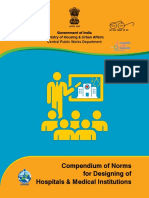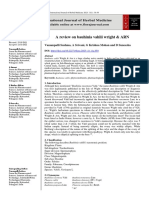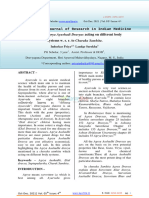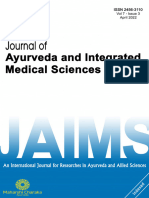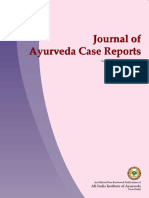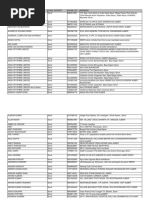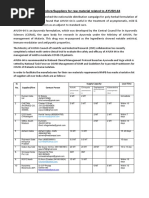Medicinal Properties of Bala
Medicinal Properties of Bala
Uploaded by
Rajesh7358Copyright:
Available Formats
Medicinal Properties of Bala
Medicinal Properties of Bala
Uploaded by
Rajesh7358Original Title
Copyright
Available Formats
Share this document
Did you find this document useful?
Is this content inappropriate?
Copyright:
Available Formats
Medicinal Properties of Bala
Medicinal Properties of Bala
Uploaded by
Rajesh7358Copyright:
Available Formats
View metadata, citation and similar papers at core.ac.
uk brought to you by CORE
provided by International Journal of Ayurveda and Pharma Research
Int. J. Ayur. Pharma Research, 2013; 1(2): 1-9 ISSN 2322 - 0910
International Journal of Ayurveda and Pharma Research
Review Article
MEDICINAL PROPERTIES OF BALA (SIDA CORDIFOLIA LINN. AND ITS SPECIES)
Ashwini Kumar Sharma
Lecturer, P.G. Dept. of Dravyaguna, Rishikul Govt. P.G. Ayurvedic College & Hospital, Haridwar, Uttarakhand,
India.
Received on: 01/10/2013 Revised on: 16/10/2013 Accepted on: 26/10/2013
ABSTRACT
The Indian system of medicine, Ayurveda, medical science practiced for a long time for
disease free life. It relies mainly upon the medicinal plants (herbs) for the management of
various ailments/diseases. Bala (Sida cordifolia Linn.) that is also known as "Indian Ephedra" is
a plant drug, which is used in the various medicines in Ayurveda, Unani and Siddha system of
medicine since ages. It has good medicinal value and useful to treat diseases like fever, weight
loss, asthma, chronic bowel complaints and nervous system disease and acts as analgesic, anti-
inflammatory, hypoglycemic activities etc.
Bala is described as Rasayan, Vishaghana, Balya and Pramehaghna in the Vedic
literature. Caraka described Bala under Balya, Brumhani dashaimani, while Susruta described
both Bala and Atibala in Madhur skandha. It is extensively used for Ayurvedic therapeutics
internally as well as externally. The root of the herb is used as a good tonic and
immunomodulator. Atibala is in Atharva Parisista along with Bala and other drugs. Caraka
described it among the Balya group of drugs whereas Carakapani considered it as Pitbala.
Atibala is quoted in the Nighantus in the context of Bala catustaya. Nagbala or Gangaruki are
not found in vedic literature. Nagbala term is used by Bruhatrayi repeatedly whereas Gangeruki
which is synonym of Nagbala is mentioned thrice only. The present review explained on the
sida species and the traditional uses, Ayurvedic preparation and pharmacological properties.
KEY WORDS: Bala, Atibala, Nagbala, Mahabala, Sida cordifolia, Abutilon indicum, Sida
veronicaefolia, Sida rhombifolia.
INTRODUCTION As a medicine more than one species of Sida
The Indian system of medicine, Ayurveda, being used as Bala, like Sida cordifolia Linn, Sida
Medical science practiced for a long time for disease acuta Burm, Sida rhombifolia Linn., Sida spinosa Linn.,
free life. Its relies mainly on the medicinal plants Sida retusa etc. Sida spinosa is also used as Sweta
(herbs) for the management of various Bala[13].
diseases/ailments. In Ayurveda a wide range of the 1. Bala – Sida Cordifolia Linn.
medicinal plants described in Nighntus and its text 2. Atibala – Abutilon indicum (Linn.) Sw.
books. Among of these plants are extinct and some 3. Nagbala – Grewia hirsute Vahl.,
are unidentified upto now. Few plants are still used as Sida veronicaefolia Lam.
the richest source of medicine since the ages. Bala Syn. Sida humilis Cav.
(Sida cordifolia Linn.) is one of such plant, which is 4. Mahabala – Sida rhombifolia Linn.
being used in the medicine of Ayurveda, Unani and They are more than one species of sida i.e
Siddha systems of medicines since ages. Sida acuta Burm., Sida. rhombifolia Linn. and Sida
Bala and its specious classified in various Spinosa Linn[14]. He also described Sida Spinosa Linn
Ayurveda samhitas as Bala dvaya (Bala, Atibala)[1-6], (Nagbala 2) and Grewia hirsuta, Vanb. (Nagbala-3)[15].
Bala traya (Bala, Atibala, Nagabala)[7-10], Bala
chatushta (Bala, Atibala, Nagbala, Mahabala)[11],
Pancha Bala (Bala, Atibala, Nagbala, Mahabala,
Rajabala)[12].
In this regard, medicinal properties of Bala
(Sida cordifolia Linn.) are being explored to
enumerate the pharmacological potential of the drug.
Available online at : http://ijapr.in Page 1
Ashwini Kumar Sharma. Medicinal Properties of Bala (Sida Cordifolia Linn. and its Species)
Vernacular names[16-20]
Bala (Sida Cordifolia Atibala (Abutilon Nagabala (Sida Mahabala (Sida
Linn) indicum) veronicaefolia) rhombifolia Linn.)
Sanskrit Badiyalaka, Bala, Atibala, Balika, Balya, Avishta, Bhadrandani, Atibala, Pitapuspi,
Baladhya, Balini, Bhadra, Bhuribala, Ghanta, Chatupala, Devadanda, Ahikhanda, Atibala, Bala,
Bhadrabala, Bhadrodani, Kankati, Kankatika, Gangeruki, Ghanta, Barela, Brihadagala,
Brela, Jayanti, Kalyanini, Rishiprokta, Shita, Gorakshatandula, Devaarha, Devabala,
Kanaka, Kathorayashtika, Shitapushpa, Vikankata, Hrisvagavedhuka, Jhasha, Devasaha, Gandhavallari,
Kharakakashtika, Vatyapushpika, Kharagandha, Gandhavalli, Jyeshthabala,
Kharayashtika, Krura, Vrishyagandha, Kharagandhini, Karambhara, Kesarika,
Motapati, Nilaya, Vrishyagandhika, Kharavallika, Keshawardhini, Keshruha,
Odanavha, Odani, Kankatika, Rshyaprokta Kharyashthika, Lalbarila, Mahabala,
Odanika, Phanijivaka, Mahagandha, Mahapatra, Mahagalarthaprasadini,
Prahasa, Raktatandula, Mahaphala, Mahagandha, Mriga,
Samanga, Samansha, Mrigadini, Mrigarasa,
Mahashakha, Mahodaya,
Shitapaki, Suvarna, Pitapushpa, Pitapushpi,
Nagabala, Pila, Pitberela,
Svetherela, Variga, Prasadini, Sahadeva,
Vishvadeva, Vishvadevi
vataghni, Vatyalaka, Sahadevi, Samanga, Sarini,
Bhumibala
Vatyali, Vatyapushpi, Varshapushpa, Varshpushpi,
Vilala Vataglini, Vatya, Vatyayani
English Country Mallow Indian Mallow Snake mallow
Family Malvaceae Malvaceae Malvaceae Malvaceae
Bengali Bala, Barila, Brela, Badela, Potari, Jhampi Junka, Bonmethi, Pitabedala, Kheriti, Pitabala,
Svetberela, Badela Gorakchaulia, Pilabarela, Pithala, Svetbarela
Gujrati Baladana, Khareti, Bal, Kansaki, Khapat, Dabali, Bhoyabala, Kantalobal, Mahabala, Baladana
Bala, Kansaki
Hindi Barial, Bariar, Khareti, Kanghi, Jhampi, Kandhi, Bananiyar, Bhiunli, Pitabala, Pitabariyar,
Kharenti, Kungyi, Kanghani, Kanghi, Kharenti, Bariara, Bariara, Bhiunli, Kharenti
Variyara Potari, Tepari, Kakahi Gangeran, Gulsakari, Pitabala, Sahadebi,
Janglimethi, Khareti Sahadeva, Swetharela
Kannada Hettuti Shrimudrigida, Kisangihettutti-gida
Mudragida, Turube,
Tutti
Malayalam Kutturam, Velluruma Uram, Katuvan, Vellula, Kattaventiyam, Anakkuruntotti, Totti,
Urubam, Urabam, Mayirmanikkam Valankuruntotti, Vatturam
Vankuruntott, Oorpam,
Tutti, Katturam,
Katturan, Pitikkapattu,
Tutti, Tuvatti, Uram,
Velluram
Marathi Chikana, Khiranti Chakrabhendi, Petari, Bhoybal, Bhuichikna, Mahbala
Mudra, Akakai, Kansuli, Gandedhaman, Gangeti,
Karandi, Madmi, Mudra, Kanteritukati
Mudrika, Pidari,
Vikankati
Punjabi Kharent, Kharayati Kangi, Kangibooti Khurunti
Tamil Arivalmanaippundu, Tutti, Thuthi, Nallatutti, Palampasi, Kurunthotti, Anaikurundotti,
Nilatutti, Paniyara tutti Paniyarattutti, Arivalmanaippundu, Kurundotti, Tenacham
Perundutti, Tutti Mayiramanikkam
Telugu Antisa, Chirubenda, Adavibenda, Botlabenda, Gayapuwaku, Gubatada, Pedda Mutheera
Muttavapulagamu, Dudi, Chinnamuttamu, Pulagum, Atibala, Gubatada,
Suvarnamu, Tellagorra, Muttavashirubenda, Chinnamuttavapulagamu, Mayilumanikyau,
tellantisa Nurubenda, Mayilumanikyam, Muttavapulagamu
Peddabenda, Muttavapulagamu,
Tittitichettu, Tutti, Ternallabenda,
Tutturubenda Tirinelabenda
Urdu Kanghi Pan
Available online at : http://ijapr.in Page 2
Int. J. Ayur. Pharma Research, 2013; 1(2): 1-9 ISSN 2322 - 0910
PROPERTIES AND ACTION
Bala[21] Atibala[22] Mahabala[23]
Rasa Madhura Madhura Madhura
Guna Laghu. snigdha, picchila, Snigdha Guru, Snigdha, Picchila
Virya Sita Sita Sita
Vipaka Madhra Madhura Madhura
Karma Vatapitta shamak, Vedanasthapana, Grahi, Vatahara, Vataghna, Pittaghna,
Shotahara, Balya,Vatahara, Grahi, Balya, Vrsya Grahi,
Hrudya, Raktapitta shamak, shukrala, Sukravrddhikara,
Prajasthapana, Mutrala, Jvaragna, Balya, Ojovardhaka,
Brumhana, Ojovardhaka K¡ntivardhaka, Balya
Botanical Description Pittaja svarabeda(58), urinary calculus and urinary
Bala disorders(59), wound healing(60).
Bala is a one of the herb in Brumhani Bala one of the drug in management of useful
dashaimani(24), Balya dashaimani(25), Madhura diet all types of Atisara(61), medicated drink in
skandha(26), Vatashamaka varga(27), Madhyama Atisara(62), Bala oil for massage of care and rituals of
Panchamula(28) new born baby(63), Bala oil with massage to Sutika
Synonyms (puerperium)(64), treatment for 6th month abortion(65),
enema in 8th month of pregnancy(66), enema therapy
Baladhya, Bhadra, Bhadrabala, Bhadraudani, in various diseases(67-69).
Kalyanini, Kharakasthika, Mahasamanga, Mota vati,
Odanahvaya, Odanika, Samamsa, Sitapaki, Udanika, Bala is one if the drug in Bala tail(70,71),
Vati, Vatya, Vatyalaka, Vatyalika, Vatyodarahvaya(29- Balamula rasayana(72), Pathadi ghruta(73), Kalashyadi
32). ghruta(74), Panchagavya ghruta(75), Sahasra paka
bala(76), Shatapaka bala taila(77), Baladi churna(78),
Bala (Sida cordifolia Linn.) is a shrubby, Bala ghrutam(79), Candanabalalakshadi taila, Baladi
branched, softly, hairy with much stellate hair nearly kvatha, Baladyarishta, Baladyaghruta(80).
all over subpersistent. Leaves are 2.5 to 5 cm. long
cordate, ovate, oblong, crenate, obtuse or subacute, In the experimental study root extract of Sida
not acuminate; petioles 1.2-3.8 cm. long. Pedicels, cordifolia shows Analgesic, Antiinflammatory and
solitary or few together, short, some up to 1.2-2 cm Hypoglycaemic activities(81), Anti microbial activity of
long, jointed much above the middle. Corolla slightly leaf extract of sida cordifolia on Staphylococcus
exceeding the calyx yellow. Fruit 6-8 mm diam. aureus, Enterococcus fecalis, Pseudomonas
carpels 7-10 strongly reticulated ciliate on the upper aeruginosa, Proteus mirabilis (bacteria), Candida
margins(33). albicans, Cryptococcus neiformans (fungi) (82).
The seeds are grayish black in colour and Sida cordifolia leaf extract posses maximum
smooth. The plant flowers from August to December activity against B. subtilis and S. aureus (18 mm) and
and fruiting occurs from October to January(34). the 16 mm similar zone of inhibition observed in E.
coli, P. fluorescens and X. a. pv. malvacearum. Root
The leaves of Bala contain small quantities of extract of this plant showed highest inhibitory
ephedrine and pseudoephedrine(35), roots and seeds activity against B. subtilis and S. aureus and least
contain alkaloid ephedrine, vasicinol, vasicinone and activity observed in E. coli(83).
N-methyl tryptophan(36-38) and are extensively used as
a common herbal drug(39,40). Due to ephedrine, Atibala
various Ayurvedic preparation of this herbs are used In the Ayurvedic text, Atibala is one of the
in asthma, fat lose, increase energy(41), chronic herb in Madhura skandha(84) Balya dashaimani(85),
dysentery and gonorrhea in the Indian Vata shamaka varga(86).
subcontinent(42.43), recently cardiovascular effects(44), Synonyms
analgesic, anti-inflammatory, and hypoglycemic Balaka, Balika, Balya, Bharavaji, Bhuribala,
activities(45) were reported for its leaves. Ghanta, Kankata, Kankatika, Rusyaprokta, Shita,
In the Ayurvedic text also Bala is useful in the Shitapushpa, Vatyapushpi, Vatyapushpika, Vikankata,
treatment of Shleshmika paittika type of diarrhea(46), Vrshyagandha, Vrukshagandhini, Vrushya,
Vatarakta(47,48) serious Vata diseases(49), Vrushyagandhika(87-90).
Galaganda (50,51), Vataja mutrakrucha , Vataja
(52)
Atibala (Abutilon indicum (Linn.) Sweet. is a
jvara(53), Pittakaphaja jvara(54), Pittaja atisara in Ama perennial softly tomentose shrub up to 3m. height.
stage(55), Kaphaja heart disease(56), Amaja trushna(57), Leaves are cordate, ovate toothed or slightly lobed,
Available online at : http://ijapr.in Page 3
Ashwini Kumar Sharma. Medicinal Properties of Bala (Sida Cordifolia Linn. and its Species)
long-petioled 3.8-7.5 cm long, stipules 9mm long, Pedicels axillary or crowded towards the ends of
linear, acute deflexed. Pedicel is often 2.5-5 cm long, branches, calyx 5-angular, hairy; lobes triangular,
axillary, solitary and is jointed very near the top. acuminate. Corolla yellow or white 8-12 mm. across.
Calyx is 12-8 mm long, divided to the middle; lobes Carpels 7-10 with 2 short awns. Seeds smooth,
ovate, apiculate. Corolla is 2.5 cm in diameter and is black(108). This plant distributed throughout the
yellow; open in the evening. Staminal tube is hairy at country especially in moist regions, ascending to an
the base; filaments long. Carpels are usually 15-20, altitude of 1800 m in the Himalayas(109).
longer than the calyx, with a distinct small acute Mahabala ghruta is one of the formulation to
point, hairy, ultimately shining and dark brown. Seeds treat the urinary, seminal and gynaecological
are brown-black, densely and minutely disorders and to help conception(110). Sukraksaya,
scrobiculate(91). Ksata, Ksaya, Visamajvara, Daurbalya, Vatavyadhi,
The flowers appear golden yellow and fruits Vatarakta, Raktapitta, Sopha(111).
are appear almost throughout the year, but mainly Mahabala is one of the formulation in Maha
seen in the months of August-December. This plant Visagarbha Taila, Navratnarajamrganka Rasa(112).
commonly found almost in every region of India and Nagbala
other countries like Sri Lanka, Pakistan, Nepal, etc. In
India, it is common weed on road sides and other Synonyms
waste places and hills upto 600 m(92,93). Akshatandula, Arishta, Balahvaya, Balottara,
Atibala is useful in the diseases like Pittaja Balya, Bhujangajihva, Gangeruki, Gavedhuka,
atisara in Ama stage(94), Vatarakta(95), Tridosha Hrasvagavedhuka, Jhasha, Jhusha, Khanda,
timira(96), Kaphaja pratishyaya(97), Vata diseases Kharagandhinika, Khirahitti, Lalajihva, Mahasamanga,
poultices purpose(98), recipe for management of the Shitabala, Shitapakini, Shitavara, Udanika, Visvadeva,
foetal malpresentations(99), urinary and the seminal Vruddhibala, Vruksharuha(113-116).
disorders(100), Meha, Raktapitta(101). Nagbala is a perennial much-branched herb;
Atibala found in the Balamula rasayana(102), branches prostrate or trailing, sometimes rooting,
Bala ghruta, Bala Taila, Narayana Taila, Maha more or less hairy. Leaves 1.2.5 cm. long, cordate,
Narayana Taila(103) formulations. ovate, acute or acuminate, serrate, sparsely clothed
with stellate hairs; petioles 1-2.2 cm. long. Pedicels
Sida acuta 1.2-3.8 cm. long, slender, axillary, solitary or twin,
Sida acuta Brum. fl. Ind. is a shrubby, much jointed a little above the middle. Calyx 4 mm. long, 5-
branched, branches slender terete, minutely stellately angled, hairy; lobes triangular, acute or acuminate.
hairy. Leaves 2.5-6.3 cm long, lanceolate with Corolla pale yellow, slightly exceeding the calyx.
rounded base sharply serrate, globrous on both sides, Carpels 5, smooth, not reticulated, muticous or with a
petioles 0-6 mm. long shorter than the stipules. small slightly 2-lipped beak, not cuspidate. Seeds
Padicels 1-2 in each axil, shorter or longer than the brown, glabrous.
petiole jointed about the middle. Calyx 6-8 mm. long, Nagbala is controversial herb. Two plants are
lobes triangular acute. Corolla nearly twice as long as mainly used with this name. One is Sida
the calyx yellow. Fruit 5-6 mm in diam., not Veronicaefolia and second is Grewia hirsuta
pubescent, strongly reticulated, toothed on the dorsal (Gangeruki).
margins. Seeds smooth black. It is found in hotter
parts of India. Generally in tropics area. In the Ayurveda Nagabala is one of the herb
in treatment of Kshaya(117), Panatyaya(118), Kasa(119),
Root sour and sweet, removes tridosha, emaciation(120), kshatakshina(121).
digestive and diuretic, useful in fever, burning of the
bosy and urinary discharges(104). Some of the formulations Satavaryadi
ghruta(122), Nagabala rasayana(123), Brahma
Mahabala rasayana (124), Indrokata rasayana(125), Yashtyahvadi
Synonyms ghruta(126), Nagabala kalpa(127), Nagabala taila(128),
Bhrhatphala, Bruhadbala, Devarha, Devasaha, Balamula rasayana(129).
Gandhavallari, Harshapuspa, Jyesthabala, Antioxidant effect(130), hepatoprotective
Katambhara, Kesavardhini, Kesharika, Kesharuha, effects (131) Abortifacient(132) properties of an extract
Mruga, Mrugadani, Mrugarasa, Pitapushpa, from Sida veronicaefolia found in the animal study.
Pitapushpi, Purasani, Sahadeva, Sahadevi, Sarini, Therapeutic uses
Varipushpi, Vatya, Vatyapuspi, Vatyayani(105-107).
1. Bala and Atibala both are taken with milk early in
Sida rhombifolia Linn. Sp. Pl. is a small erect the morning in Slipada.
under shrub, branches rough with stellate hairs. 2. Decoction of Atibala is useful in mutrakrchra.
Leaves very variable in shape up to 5 cm by 18 mm 3. Root powder of Atibala is given with sugar and
glabrous or subglabrous above grey-pubescent or honey.
hoary beneath, coarsely dentate towards the tip 4. Powder of Atibala, Bala and Devdaru is given
entire towards the base 3-5 nerved. Petiole up to 6 internally for galganda.
mm. long, pubescent swollen in the upper third.
Available online at : http://ijapr.in Page 4
Int. J. Ayur. Pharma Research, 2013; 1(2): 1-9 ISSN 2322 - 0910
5. Seeds of Atibala is useful in impotency, piles and The root bark decoction is used as a
urinary tract infection. demulcent in irritability of the bladder and in
6. Caraka mentioned Bala in so many diseases with gonorrhoea. The root is also used as a gentle tonic
different forms like(134). and diaphoretic and is employed in mild cases of
7. In Raktapitta-used Bala root should be used with debility and fever(140).
cow milk Anupan. The root of the Sida acuta is sour and sweet,
8. In bleeding piles –Milk or Ghee should be siddha removes "Tridosha", digestive and diuretic, useful in
by Bala and Prishnaparni and should be taken fever, burning of the body and urinary discharges
internally. mentioned in Ayurveda. The root is cooling,
9. In Gout-Prepare oil with Bala root Kalk and astringent, tonic and useful in nervous and urinary
decoction and use it internally and externally for diseases and in blood and bile disorders.
management of gout. It can be used with ginger in intermittent
Traditional Medicinal Uses fever. This is considered by the Hindoo practitioners
In Ayurvedic texts this is mentioned that Bala as a valuable stomachic and useful remedy of chronic
is Madhura in Ras and Vipaka, Laghu, Snigdha, bowel complaints.
Picchila in Guna and Sita Virya. It is Vat Pitta hara, In the gold cast the plant is used to cure
Balya, Brmhana and Vrishya Karm(135). It is reputed veneral diseases(141).
herb for its tonic and aphrodisiac properties. The The root and leaves of Sida rombifolia are
parts of plant are useful in various diseases like fever, sweetish, aphrodisiac, tonic, tridoshahar best for
fits, leucorrhoea, micturition, gonorrhoea colic, urinary complaints, discharges and strangury, useful
nervous disorders, general debility and heart in fever, heart diseases, burning sensations, piles and
irregularity. inflammation.
The roots and leaves of Sida rhombifolia Linn. The roots of its herb is a good treatment of
are bitter, sweet, emollient, cooling, aphrodisiac, rheumatism. In Assam the roots are taken internally
unctuous, strengthening and promote sexual vigour to control childbirth and it is also tied round the
and vital factor. These are good for rheumatism, abdomen for same purpose.
flatulence, colic, haemothermia, emaciation, vitiated
conditions of Tridosha, seminal weakness, arthritis It is also used as a valuable remedy in
and diarrhoea(136). pulmonary tuberculosis and rheumatism in Europe.
Phyto chemistry Sida cordifolia is slightly bitter and sweet,
tonic, astringent, emollient, aphrodisiac, Vataghan
Chemical constituents and Pittaghan. The bark cures urinary troubles and
Ephadrine, Hypapharine, Vasicinone, discharges. Its fruits are acrid and sweet, digestive,
Vascicine, vasicinol, Choline, Betain Phytoosterol are cooling, astringent, aphrodisioc, remove Pitta and
mainly found in Sida and its species. cough, increases Vata, useful in blood disorders,
The following alkaloids has been found in bleeding piles, throat disease, phthisis and insanity. It
Sida Cordifolia and its species B. Phenthylamine, is mentioned in Ayurveda texts.
Ephadrine, Pseudo-ephadrine, S – (+) – Nb – Hindu physicians used root decoction with
methyltryptophan methyl ester, hypahorine, ginger in intermittent fever and also used in fever
Vasicinone, Vasicinol, Choline and betaine(137). accompanied with shivering fits and strong heat of
Steurlic, malvalic and coronaric acids have the body.
been isolated from Sida seeds oil along with other The root bark is used with sesamum oil and
fatty acids. milk is very efficacious in curing cases of facial
Hescaes, n-alkane mixtures, alkanols, B- paralysis and sciatica when caused by the
sitosterol, Vanillic, P-coumaric, caffeic, fumaric and inflammation of the nervous concerned(142).
amino acids, alantolactone, isolantalactone are major 1-Crude extract of Sida rhombifolia produced
chemical constituents in it(138). sedative effect and significant potentiation of
Pharmacological Actions phenobarbitone sleeping time in mice. Extract did not
The flowers and unripe fruits are given with produce any change in normal temperature of mice
sugar in burning sensation in micturition(139). but 10 gm /kg dose showed significant decrease in
The root, leaf and fruits are Kaphahara and rectal temperature of pyretic rats 2 and 3 hours after
Vatahar, cures ulcers and biliousness and also useful administration(143).
in urinary discharge, scalding urine, leprosy and skin 2-In an experimental study on the Rasayana
infections, the fruit is also astringent and cooling. drugs viz. Bala, Atibala, Mahabala & Bhumibala have
Mentioned in Ayurvedic texts. been screened for their immune –enhancing
The leaves are demulcent and refrigerant and properties. Animals of drugs treated of group showed
are useful in gonorrhoea, gleet and scalding urine. statistically an enhanced production of anti S.typhi o
Available online at : http://ijapr.in Page 5
Ashwini Kumar Sharma. Medicinal Properties of Bala (Sida Cordifolia Linn. and its Species)
antibodies. Abutilon indicum (Atibala) was the best It also has anti pyretic, Anti-inflammatory,
drug in augmenting antibody production (Dixit 1978). contraceptive, anti fungal activity; It is a best nervine
CONCLUSION tonic for various neuro motor diseases like paralysis
From the above it can be concluded that the sciatica etc.
drug Bala (Sida Cordifolia and its species) proved to Thus it can be concluded that the drug is
have extensive medicinal value in the treatment of explored can become a single drug remedy for many
diseases like fever, urinary system, abdominal, pathological conditions on an effective cost and
Neurological disorder etc. available easily.
REFERENCES Mahaskar K.S. Published by Mohan Basu Lalit,
1. Charaka Samhita, Translation: Ram Karan Allhabhad. 1984. Vol. -1. p. 312.
Sharma & Vaidya Bhagwan Dash, Chowkambha 18. The Ayurvedic Pharmacopoeia of India Part-1,
Sanskrit Series office, Varanasi. Reprint: 2008; Vol- 1, Dept. of AYUSH, Ministry of Health and
Vol-5; p. 64-65. Family Welfare, Govt. of India. Edition: 1996, p.
2. Prof. Sudarshana Shashtri & Prof. Kaviratna 20-21.
Sharma, Original Text And Dalhana’s 19. The Ayurvedic Pharmacopoeia of India Part-1,
Nibandhasangraha Commentary With Hindi Vol- 3, Dept. of AYUSH, Ministry of Health and
Translation, R.A.V.Publication, New Delhi, 1st Family Welfare, Govt. of India. Edition: 2001, p.
Edition 2002, p. 370. 110-111.
3. Astanga Hrdayam, Translation: Prof. K. R. 20. http://www.toxicologycentre.com/English/plant
Srikantha Murthy, Chowkhamba Krishnadas s/Botanical/vallikkuruntotti.html (as on date:
Academy, Varanasi. Reprint: 2009; Vol-1; p. 200. 1/10/2013).
4. Vagbhata’s Astanga Hrdayam, Translation: Prof. 21. Prof. P.V.Sharma. Dravyaguna vijnana Vol-2,
K. R. Srikantha Murthy, Chowkhamba Krishnadas Chaukhambha Bharathi Academy, Varanasi.
Academy, Varanasi. Reprint: 2009; Vol-3; p. 20. Reprint: 2009, p.735.
5. Ibid. p. 209-210 22. The Ayurvedic Pharmacopoeia of India Part-1,
6. Bhavaprakasa of Bhavamisra, Translation: Dr. Vol- 1, Dept. of AYUSH, Ministry of Health and
Bulusu Sitaram publisher, Chaukhambha Family Welfare, Govt. of India. Edition: 1996, p.
Orientalia, Varanasi. Vol-1, Edition: 2006; p. 265- 20-21
266. 23. The Ayurvedic Pharmacopoeia of India Part-1,
7. Vagbhata’s Astanga Hrdayam, Translation: Prof. Vol- 3, Dept. of AYUSH, Ministry of Health and
K. R. Srikantha Murthy, Chowkhamba Krishnadas Family Welfare, Govt. of India. Edition: 2001, p.
Academy, Varanasi. Reprint: 2009; Vol-1; p. 147. 110-111.
8. Vagbhata’s Astanga Hrdayam, Translation: Prof. 24. Charaka Samhita, Translation: Ram Karan
K. R. Srikantha Murthy, Chowkhamba Krishnadas Sharma & Vaidya Bhagwan Dash, Chowkambha
Academy, Varanasi. Reprint: 2009; Vol-3; p. 263. Sanskrit Series office, Varanasi. Reprint: 2008;
9. Ibid. p. 122. Vol-1; p.88.
10. Bhavaprakasa of Bhavamisra, Translation: Dr. 25. Ibid. p. 89-90.
Bulusu Sitaram publisher, Chaukhambha 26. Prof. G.D. Singhal & Colleagues, Susruta-Samhita
Orientalia, Varanasi. Vol-1, Edition: 2006; Page Ancient Indian Surgery, Chaukhamba Sanskrit
No: 265-266. Pratishthan, Delhi. Reprint: 2007: Vol: 1; p. 346.
11. Ibid. p. 265-266. 27. Ibid. p. 323.
12. Prof. P.V.Sharma. Dravyaguna vijnana Vol-2, 28. Ibid. p. 107.
Chaukhambha Bharathi Academy, Varanasi. 29. Dhanvantari Nighantu with Hindhi translation &
Reprint: 2009, p. 735-738. commentary. Edited & Commentrated by
13. Bhavaprakasa of Bhavamisra, Translation: Dr. Jharkhandey Ojha, Umapati Mishra, Adarsha
Bulusu Sitaram publisher, Chaukhambha vidyanikhetan, Varanasi. 1985. p. 97.
Orientalia, Varanasi. Vol-1, Edition: 2006; p. 265- 30. Rajanighantu of Pandit Narahari by Dr.Indradev
266. Tripathi, Chowkhambha Krishnadas Academy,
14. Thakur Balwant singh. Glossary of Vegitable Varanasi. 2006; p. 80.
drugs in Brhattrayi, Chaukhamba Amarabharati 31. Bhavaprakasa of Bhavamisra, Translation: Dr.
Prakashan, Varanasi. second edition: 1999. p. Bulusu Sitaram publisher, Chaukhambha
270. Orientalia, Varanasi. Vol-1, Edition: 2006; p. 265-
15. Bhav Misra Commented by Chunekar K.C. Edited 266.
by Pandey G.S. Edition 2006-366, p. 370, 371- 32. Illustrated Madanapala Nighantu by J.L.N.
372. Shastry., Chaukhambha Orientalia, Varanasi.
16. Prof. P.V.Sharma. Dravyaguna vijnana Vol-2, 2010, p. 141.
Chaukhambha Bharathi Academy, Varanasi. 33. Kirtikar KR, Basu BS. Indian Medicinal Plants. 2nd
Reprint: 2009, p. 735. Edition. Revised by Blatter E., Caius J.F. and
17. Kirtikar KR, Basu BS. Indian Medicinal Plants. 2nd Mahaskar K.S. Published by Mohan Basu Lalit,
Edition. Revised by Blatter E., Caius J.F. and Allhabhad. 1984. Vol. -1. p. 312.
Available online at : http://ijapr.in Page 6
Int. J. Ayur. Pharma Research, 2013; 1(2): 1-9 ISSN 2322 - 0910
34. R.S. Pawar et al. Sida cordifolia (Linn) – An 55. Ibid. p. 257.
overview. Journal of Applied Pharmaceutical 56. Ibid. p. 317.
Science 01 (02); 2011: p. 23-31. 57. Ibid. p. 368.
35. Ghasal S. Chauhan RRPS and Mehta R. Alkaloids 58. Ibid. p. 410.
of Sida cordifolia Linn. Phytotherapy Chemistry. 59. Ibid. p. 447.
1975; 14: p. 830-832. 60. Prof. G.D. Singhal & Colleagues, Susruta-Samhita
36. Kirtikar K.R., Basu B.D. Indian Medicinal Plants Ancient Indian Surgery, Chaukhamba Sanskrit
Vol.-1, Second Edition. Dehradun; International Pratishthan, Delhi. Reprint: 2007: Vol: 2; p. 318.
book distributors – 1980; p. 307, 308, 309, 61. Prof. G.D. Singhal & Colleagues, Susruta-Samhita
311312, 314. Ancient Indian Surgery, Chaukhamba Sanskrit
37. Jain Ankit, Choubey Shreya, Singour PK., Rajak H. Pratishthan, Delhi. Reprint: 2007: Vol: 3; p. 265.
and Pawar RS. Sida cordifolia L. – An overview. 62. Ibid. p. 261.
Journal of Applied Pharmaceutical Science 2011; 63. Prof. G.D. Singhal & Colleagues, Susruta-Samhita
1(2) : 23-31. Ancient Indian Surgery, Chaukhamba Sanskrit
38. Chopra RN, Handa KL. and Kapur LD. Chopra's Pratishthan, Delhi. Reprint: 2007: Vol: 2; p. 119.
Indigenous drugs of India 2nd Edition, Academic 64. Ibid. p. 120.
Publishers. 1958; p. 409 65. Ibid. p. 133.
39. Kirtikar K.R., Basu B.D. Indian Medicinal Plants 66. Ibid. p. 116.
Vol.-1, Second Edition. Dehradun; International 67. Charaka Samhita, Translation: Ram Karan
book distributors – 1980; p. 307, 308, 309, Sharma & Vaidya Bhagwan Dash, Chowkambha
311312, 314. Sanskrit Series office, Varanasi. Reprint: 2008;
40. Anonymous. The Wealth of India. A dictionary of Vol-1; p. 66.
Indian raw material and Industrial products, New 68. Prof. G.D. Singhal & Colleagues, Susruta-Samhita
Delhi, Publication and Information Directorate Ancient Indian Surgery, Chaukhamba Sanskrit
CSIR. 1988: p. 323-324. Pratishthan, Delhi. Reprint: 2007: Vol: 3; p. 324.
41. Anonymous. The Wealth of India. A dictionary of 69. Prof. G.D. Singhal & Colleagues, Susruta-Samhita
Indian raw material and Industrial products, New Ancient Indian Surgery, Chaukhamba Sanskrit
Delhi, Publication and Information Directorate Pratishthan, Delhi. Reprint: 2007: Vol: 2; p. 521-
CSIR. 1988: p. 323-324. 524, 526.
42. Chopra RN, Handa KL. and Kapur LD. Chopra's 70. Charaka Samhita, Translation: Ram Karan
Indigenous drugs of India 2nd Edition, Academic Sharma & Vaidya Bhagwan Dash, Chowkambha
Publishers. 1958; p.409. Sanskrit Series office, Varanasi. Reprint: 2008;
43. Yusuf M and Kabir M. Medicinal plants of Vol-5; p. 61-62.
Bangladesh, Dakha Bangladesh. Council of 71. Prof. G.D. Singhal & Colleagues, Susruta-Samhita
Scientific and Industrial Research CSIR 1999 : p. Ancient Indian Surgery, Chaukhamba Sanskrit
226. Pratishthan, Delhi. Reprint: 2007: Vol: 2; p. 306.
44. Mediros IA., Santos MR., Nascimento NM. and 72. Ibid. P.413.
Durate JC. Cardiovascular effects of Sida 73. Prof. G.D. Singhal & Colleagues, Susruta-Samhita
Cordifolia L. leaves extracts in rats Fitoterapia; Ancient Indian Surgery, Chaukhamba Sanskrit
2006 : 77 ; p. 19-27. Pratishthan, Delhi. Reprint: 2007: Vol: 3; p.403.
45. Kanth VR and Diwan PV. Analgesic anti 74. Ibid. p.232.
inflammatory and hypoglycamic activities of Sida 75. Ibid. p.234.
Cordifolia L., Phytother Res. 1999 ; 13; p. 75-77. 76. Charaka Samhita, Translation: Ram Karan
46. Charaka Samhita, Translation: Ram Karan Sharma & Vaidya Bhagwan Dash, Chowkambha
Sharma & Vaidya Bhagwan Dash, Chowkambha Sanskrit Series office, Varanasi. Reprint: 2008;
Sanskrit Series office, Varanasi. Reprint: 2008; Vol-5; p. 116-117.
Vol-1; p. 70. 77. Ibid. p. 116-117.
47. Ibid. p. 79. 78. Bhavaprakasa of Bhavamisra, Translation: Dr.
48. Prof. G.D. Singhal & Colleagues, Susruta-Samhita Bulusu Sitaram publisher, Chaukhambha
Ancient Indian Surgery, Chaukhamba Sanskrit Orientalia, Varanasi. Vol-2, Edition: 2010; p. 191.
Pratishthan, Delhi. Reprint: 2007: Vol: 2; p. 208. 79. Ibid. p. 341.
49. Ibid. p. 205. 80. Prof. P.V.Sharma. Dravyaguna vijnana Vol-2,
50. Ibid. p. 331. Chaukhambha Bharathi Academy, Varanasi.
51. Prof. G.D. Singhal & Colleagues, Susruta-Samhita Reprint: 2009, p. 735-736.
Ancient Indian Surgery, Chaukhamba Sanskrit 81. V. Ravi Kanth and P. V. Diwan. Analgesic,
Pratishthan, Delhi. Reprint: 2007: Vol: 3; p. 504. Antiinflammatory and Hypoglycaemic Activities
52. Ibid. 455. of Sida cordifolia. Phytother. Res. 13, 75–77
53. Ibid. p. 226. (1999).
54. Ibid. p. 229.
Available online at : http://ijapr.in Page 7
Ashwini Kumar Sharma. Medicinal Properties of Bala (Sida Cordifolia Linn. and its Species)
82. Serasanambati Mamatha Reddy, Challa Krishna 100. Prof. G.D. Singhal & Colleagues, Susruta-Samhita
Kumari, Chilakapati Shanmuga Reddy, Yakkanti Ancient Indian Surgery, Chaukhamba Sanskrit
Raja Ratna Reddy, Chilakapati Damodar Reddy. Pratishthan, Delhi. Reprint: 2007: Vol: 3; p.449.
International Research Journal of Pharmacy 101. The Ayurvedic Pharmacopoeia of India Part-1,
2012, 3 (9) 309-311 Vol- 1, Dept. of AYUSH, Ministry of Health and
83. B. Mahesh and S. Satish. Antimicrobial Activity of Family Welfare, Govt. of India. Edition: 1996, p.
Some Important Medicinal Plant Against Plant 20-21.
and Human Pathogens. World Journal of 102. Prof. G.D. Singhal & Colleagues, Susruta-Samhita
Agricultural Sciences 4 (S): 839-843, 2008. Ancient Indian Surgery, Chaukhamba Sanskrit
84. Prof. G.D. Singhal & Colleagues, Susruta-Samhita Pratishthan, Delhi. Reprint: 2007: Vol: 2; p.413.
Ancient Indian Surgery, Chaukhamba Sanskrit 103. The Ayurvedic Pharmacopoeia of India Part-1,
Pratishthan, Delhi. Reprint: 2007: Vol: 1; p.346. Vol- 1, Dept. of AYUSH, Ministry of Health and
85. Charaka Samhita, Translation: Ram Karan Family Welfare, Govt. of India. Edition: 1996, pp.
Sharma & Vaidya Bhagwan Dash, Chowkambha 20-21.
Sanskrit Series office, Varanasi. Reprint: 2008; 104. Kirtikar KR, Basu BS. Indian Medicinal Plants. 2nd
Vol-1; p. 89-90. Edition. Revised by Blatter E., Caius J.F. and
86. Prof. G.D. Singhal & Colleagues, Susruta-Samhita Mahaskar K.S. Published by Mohan Basu Lalit,
Ancient Indian Surgery, Chaukhamba Sanskrit Allhabhad. 1984. Vol. -1. P. 308.
Pratishthan, Delhi. Reprint: 2007: Vol: 1; p.323. 105. Dhanvantari Nighantu with Hindhi translation &
87. Dhanvantari Nighantu with Hindhi translation & commentary. Edited & Commentrated by
commentary. Edited & Commentrated by Jharkhandey Ojha, Umapati Mishra, Adarsha
Jharkhandey Ojha, Umapati Mishra, Adarsha vidyanikhetan, Varanasi. 1985. p. 97.
vidyanikhetan, Varanasi. 1985. p. 98. 106. Rajanighantu of Pandit Narahari by Dr.Indradev
88. Rajanighantu of Pandit Narahari by Dr.Indradev Tripathi, Chowkhambha Krishnadas Academy,
Tripathi, Chowkhambha Krishnadas Academy, Varanasi. 2006; p. 81.
Varanasi. 2006; p. 81. 107. Bhavaprakasa of Bhavamisra, Translation: Dr.
89. Bhavaprakasa of Bhavamisra, Translation: Dr. Bulusu Sitaram publisher, Chaukhambha
Bulusu Sitaram publisher, Chaukhambha Orientalia, Varanasi. Vol-1, Edition: 2006; p. 265-
Orientalia, Varanasi. Vol-1, Edition: 2006; p. 265- 266.
266. 108. Kirtikar KR, Basu BS. Indian Medicinal Plants. 2nd
90. Illustrated Madanapala Nighantu by J.L.N. Edition. Revised by Blatter E., Caius J.F. and
Shastry., Chaukhambha Orientalia, Varanasi. Mahaskar K.S. Published by Mohan Basu Lalit,
2010, p. 144. Allhabhad. 1984. Vol. -1. p. 310.
91. Kirtikar KR, Basu BS. Indian Medicinal Plants. 2nd 109. The Ayurvedic Pharmacopoeia of India Part-1,
Edition. Revised by Blatter E., Caius J.F. and Vol- 3, Dept. of AYUSH, Ministry of Health and
Mahaskar K.S. Published by Mohan Basu Lalit, Family Welfare, Govt. of India. Edition: 2001, p.
Allhabhad. 1984. Vol. -1. p. 314. 110-111.
92. Dhiman, A.K. Wild Medicinal Plants of India. 110. Prof. G.D. Singhal & Colleagues, Susruta-Samhita
Bishen Singh Mahendra Pal Singh, Dehradun. p. Ancient Indian Surgery, Chaukhamba Sanskrit
86–88 (2005). Pratishthan, Delhi. Reprint: 2007: Vol: 3; p. 450.
93. The Ayurvedic Pharmacopoeia of India Part-1, 111. The Ayurvedic Pharmacopoeia of India Part-1,
Vol- 1, Dept. of AYUSH, Ministry of Health and Vol- 3, Dept. of AYUSH, Ministry of Health and
Family Welfare, Govt. of India. Edition: 1996, p. Family Welfare, Govt. of India. Edition: 2001, p.
20-21. 110-111.
94. Prof. G.D. Singhal & Colleagues, Susruta-Samhita 112. Ibid. p. 110-111.
Ancient Indian Surgery, Chaukhamba Sanskrit 113. Dhanvantari Nighantu with Hindhi translation &
Pratishthan, Delhi. Reprint: 2007: Vol: 3; p. 257. commentary. Edited & Commentrated by
95. Prof. G.D. Singhal & Colleagues, Susruta-Samhita Jharkhandey Ojha, Umapati Mishra, Adarsha
Ancient Indian Surgery, Chaukhamba Sanskrit vidyanikhetan, Varanasi. 1985. p. 98.
Pratishthan, Delhi. Reprint: 2007: Vol: 2; P.208. 114. Rajanighantu of Pandit Narahari by Dr.Indradev
96. Prof. G.D. Singhal & Colleagues, Susruta-Samhita Tripathi, Chowkhambha Krishnadas Academy,
Ancient Indian Surgery, Chaukhamba Sanskrit Varanasi. 2006; p. 80.
Pratishthan, Delhi. Reprint: 2007: Vol: 3; p. 88 115. Bhavaprakasa of Bhavamisra, Translation: Dr.
97. Ibid. p.149 Bulusu Sitaram publisher, Chaukhambha
98. Prof. G.D. Singhal & Colleagues, Susruta-Samhita Orientalia, Varanasi. Vol-1, Edition: 2006; p. 265-
Ancient Indian Surgery, Chaukhamba Sanskrit 266.
Pratishthan, Delhi. Reprint: 2007: Vol: 2; P.205. 116. Illustrated Madanapala Nighantu by J.L.N.
99. Ibid. P.307. Shastry., Chaukhambha Orientalia, Varanasi.
2010, p. 145.
Available online at : http://ijapr.in Page 8
Int. J. Ayur. Pharma Research, 2013; 1(2): 1-9 ISSN 2322 - 0910
117. Prof. G.D. Singhal & Colleagues, Susruta-Samhita 132. Lutterodt GD. Abortifacient properties of an
Ancient Indian Surgery, Chaukhamba Sanskrit extract from Sida veronicaefolia. J
Pratishthan, Delhi. Reprint: 2007: Vol: 3; p. 289. Ethnopharmacol. 1988 May-Jun; 23(1):27-37.
118. Ibid. p. 352. 133. Bhav Misra Commented by Chunekar K.C. Edited
119. Ibid. p. 406. by Pandey G.S. Edition 2006-366, p. 370, 371-372
120. Prof. G.D. Singhal & Colleagues, Susruta-Samhita 134. Tripathi RD, Shukla VD., Caraka Samhita
Ancient Indian Surgery, Chaukhamba Sanskrit elaborated by Caraka and redacted by Drdhbala
Pratishthan, Delhi. Reprint: 2007: Vol: 1; p. 139. Volume 2 nd Chikitsa Sthanam ch.4, page -133,
121. Charaka Samhita, Translation: Ram Karan ch.14, ch.29, p.-738.
Sharma & Vaidya Bhagwan Dash, Chowkambha 135. Bhavaprakasa of Bhavamisra, Translation: Dr.
Sanskrit Series office, Varanasi. Reprint: 2008; Bulusu Sitaram publisher, Chaukhambha
Vol-3; p. 479-480. Orientalia, Varanasi. Vol-1, Edition: 2006; p. 265-
122. Prof. G.D. Singhal & Colleagues, Susruta-Samhita 266.
Ancient Indian Surgery, Chaukhamba Sanskrit 136. Ghosal S. Chauhan RRPS and Mehta R. Alkaloids
Pratishthan, Delhi. Reprint: 2007: Vol: 3; p.406. of Sida Cordifolia L. Phytotherapy, Chemistry.
123. Charaka Samhita, Translation: Ram Karan 1975; 14:830-832.
Sharma & Vaidya Bhagwan Dash, Chowkambha 137. Ibid. p. 830-832.
Sanskrit Series office, Varanasi. Reprint: 2008; 138. Bhavaprakasa of Bhavamisra, Translation: Dr.
Vol-3; p. 32-33. Bulusu Sitaram publisher, Chaukhambha
124. Ibid. p. 18-19. Orientalia, Varanasi. Vol-1, Edition: 2006; p. 265-
125. Ibid. p. 57-58, 61-62. 266.
126. Ibid. p. 465-466. 139. Bhav Misra Commented by Chunekar K.C. Edited
127. Ibid. p. 479-480. by Pandey G.S. Edition 2006-366, p. 370, 371-
128. Bhavaprakasa of Bhavamisra, Translation: Dr. 372.
Bulusu Sitaram publisher, Chaukhambha 140. Kirtikar K.R., Basu B.D. Indian Medicinal Plants
Orientalia, Varanasi. Vol-2, Edition: 2010; p. 347. Vol.-1, Second Edition. Dehradun; International
129. Prof. G.D. Singhal & Colleagues, Susruta-Samhita book distributors – 1980; p. 307, 308, 309,
Ancient Indian Surgery, Chaukhamba Sanskrit 311312, 314.
Pratishthan, Delhi. Reprint: 2007: Vol: 2; p. 413. 141. Kirtikar K.R., Basu B.D. Indian Medicinal Plants
130. Pandey Manisha, Verma Rohit K, Vol.-1, Second Edition. Dehradun; International
Dharamveer, Koshy MK, Saraf Shubhini A. book distributors – 1980; p. 307, 308, 309,
Antioxidant Activity of Sida veronicaefolia. 311312, 314.
Research Journal of Pharmacognosy and 142. Koman : Indian med. Gazette Aug. 1921.
Phytochemistry, 2010 2 (1) 79-51. 143. Japanes J. Pharm., 21:136, 1971.
131. Ajay Sharma, Balakrishnan Sangameswaran,
Suresh Chandra Mahajan, Manmeet Singh Saluja.
Protective effects of Sida veronicaefolia against
ethanol induced hepatotoxicity in experimental *Address for correspondence
animals. Phytopharmacology 2012, 3(1) 137-144 Dr. Ashwini Kumar Sharma
Lecturer, P.G. Dept. of Dravya Guna
Rishikul Govt. P.G. Ayurvedic College &
Cite this article as:
Hospital
Ashwini Kumar Sharma. Medicinal Properties of Bala (Sida Haridwar, Uttarakhand, India.
Cordifolia Linn. and its Species). Int. J. Ayur. Pharma Research Cell No: +918449910094
2013; 1 (2): 1-9. Email: drashwinisharma1972@gmail.com
Source of support: Nil, Conflict of interest: None Declared
Available online at : http://ijapr.in Page 9
You might also like
- NORMSDocument236 pagesNORMSpankaj agrawal100% (2)
- Medicinal Importance of Darbha-A Review: January 2016Document8 pagesMedicinal Importance of Darbha-A Review: January 2016yish ChaudhariNo ratings yet
- VVI Notes For PrelimsDocument165 pagesVVI Notes For PrelimsUddish Naik EslavathNo ratings yet
- Review Article On VarahikandaDocument13 pagesReview Article On VarahikandaPragha ThiswarenNo ratings yet
- Lant With Medicine ValveDocument9 pagesLant With Medicine Valvecrazy boyNo ratings yet
- 491-Article Text-1441-1-10-20161206Document16 pages491-Article Text-1441-1-10-20161206Vande GuruParamparaNo ratings yet
- Sari Va ArticleDocument6 pagesSari Va Articleharshalgangave111No ratings yet
- A Synoptic Overview On Boerhavia DiffusaDocument7 pagesA Synoptic Overview On Boerhavia DiffusaAnonymous pqtS3tcu1No ratings yet
- PUNARNAVA MiracleDocument5 pagesPUNARNAVA MiracleAlluNo ratings yet
- Sariva DvayaDocument25 pagesSariva DvayaSoumyashree K MNo ratings yet
- Topical Dosages Forms (Lepa Kalpana) of Ayurveda: An Unexplored TreasureDocument8 pagesTopical Dosages Forms (Lepa Kalpana) of Ayurveda: An Unexplored TreasureKhushi PansuriaNo ratings yet
- 2489-Article Text-7646-1-10-20190414Document8 pages2489-Article Text-7646-1-10-20190414Chaitu ChaiNo ratings yet
- 10.single Drug Therapy in Ardhavabhedaka With Special Reference To Migraine - A Review PDFDocument5 pages10.single Drug Therapy in Ardhavabhedaka With Special Reference To Migraine - A Review PDFk2kkhanna105No ratings yet
- Medical ProjectDocument50 pagesMedical Projectharshavardhana00078No ratings yet
- Controversial PlantsDocument14 pagesControversial PlantsSundara VeerrajuNo ratings yet
- Research A Clinical Study of Kutaja (Holarrhena Antidysenterica Wall) On Shonitarsha-Ayur ResearchDocument4 pagesResearch A Clinical Study of Kutaja (Holarrhena Antidysenterica Wall) On Shonitarsha-Ayur ResearchDrHassan Ahmed ShaikhNo ratings yet
- Topical Dosages Forms (Lepa Kalpana) of Ayurveda: An Unexplored TreasureDocument9 pagesTopical Dosages Forms (Lepa Kalpana) of Ayurveda: An Unexplored TreasureKhushi PansuriaNo ratings yet
- Ayush 4517140Document6 pagesAyush 4517140sparshNo ratings yet
- 5 2 27 713Document3 pages5 2 27 713veereshchiremathNo ratings yet
- Classical Review On MundiDocument12 pagesClassical Review On MundiPavel PeresypkinNo ratings yet
- 2.1 Dravyaguna VigyanDocument14 pages2.1 Dravyaguna VigyanForget PasswordNo ratings yet
- 885-Article Text-1958-1-10-20220518Document5 pages885-Article Text-1958-1-10-20220518Abhishek GuptaNo ratings yet
- Ashoka Boon For RWomenDocument6 pagesAshoka Boon For RWomenawardrkholinNo ratings yet
- A Review On Bauhinia Vahlii Wright & ARN: Vanampalli Sushma, A Srivani, G Krishna Mohan and D SuneeshaDocument10 pagesA Review On Bauhinia Vahlii Wright & ARN: Vanampalli Sushma, A Srivani, G Krishna Mohan and D SuneeshaPriyanka SujithNo ratings yet
- Aragvadha Plant PDFDocument6 pagesAragvadha Plant PDFAnonymous pqtS3tcu1No ratings yet
- Dictionary of Medicinal Plants 64 Book Manuscript 593 1 10 20190829Document95 pagesDictionary of Medicinal Plants 64 Book Manuscript 593 1 10 20190829Madhuritha Rajapakse100% (1)
- 596-Article Word Document-2017-1-10-20211012Document8 pages596-Article Word Document-2017-1-10-20211012Mohika GNo ratings yet
- Topical Dosage Form Lepa KalpanaDocument9 pagesTopical Dosage Form Lepa Kalpanaanon_712618409No ratings yet
- 132-Article Text-391-1-10-20151214Document5 pages132-Article Text-391-1-10-20151214Dr.Mahesh kumar GuptaNo ratings yet
- 522-Article Text-1004-1-10-20180408Document7 pages522-Article Text-1004-1-10-20180408SergeyNo ratings yet
- Concept of Aushadha Dharna Tying Some Parts of MedDocument5 pagesConcept of Aushadha Dharna Tying Some Parts of MedD MNo ratings yet
- Daruharidra 2Document6 pagesDaruharidra 2nileshmpharmNo ratings yet
- Article On Millets As Per AyurvedaDocument9 pagesArticle On Millets As Per AyurvedaKRIPANo ratings yet
- Contribution of Bhaishajya Ratnavali To Ayurveda PharmaceuticsDocument8 pagesContribution of Bhaishajya Ratnavali To Ayurveda PharmaceuticsLenskart OfferNo ratings yet
- Gojihwadi Kwath - A Drug ReviewDocument10 pagesGojihwadi Kwath - A Drug ReviewIJAR JOURNALNo ratings yet
- Conceptofbalya InayurvedaDocument53 pagesConceptofbalya InayurvedamandrakeNo ratings yet
- 837-Article Text-1701-1-10-20210426Document17 pages837-Article Text-1701-1-10-20210426Rishabh AgrahariNo ratings yet
- Use of Trina Dhanya According To Aahara Vidhi VishDocument4 pagesUse of Trina Dhanya According To Aahara Vidhi Vishumapati 1505No ratings yet
- Dwibhuja Rasa A Herbo Mineral Formulation ReviewDocument3 pagesDwibhuja Rasa A Herbo Mineral Formulation ReviewEditor IJTSRDNo ratings yet
- Chem PDFDocument4 pagesChem PDFAnchal JhaNo ratings yet
- Herbs of Bhavaprakash Nighantu W.S.R. To Medoroga (Obesity)Document7 pagesHerbs of Bhavaprakash Nighantu W.S.R. To Medoroga (Obesity)IJAR JOURNALNo ratings yet
- Kenchappa Gambhari Compilation.Document76 pagesKenchappa Gambhari Compilation.Pavan PatilNo ratings yet
- Compilation of AstaVarga PlantsDocument16 pagesCompilation of AstaVarga PlantsAbhilash JanakkiNo ratings yet
- Therapeutic Uses of Vanga Bhasma A Criti PDFDocument5 pagesTherapeutic Uses of Vanga Bhasma A Criti PDFMSKCNo ratings yet
- BAMS IInd Year (06122017) PDFDocument22 pagesBAMS IInd Year (06122017) PDFDipesh MallickNo ratings yet
- 6.lakshaharidradidhoopa2422 2426Document6 pages6.lakshaharidradidhoopa2422 2426Vijayalakshmy K GNo ratings yet
- Essential Leafy Vegetables For Healthy Eyes: November 2016Document5 pagesEssential Leafy Vegetables For Healthy Eyes: November 2016Gitanj ShethNo ratings yet
- Indian Medicinal PlantsDocument2 pagesIndian Medicinal PlantsAbhi RamNo ratings yet
- Original Research Paper: KeywordsDocument2 pagesOriginal Research Paper: KeywordsAmitNo ratings yet
- 4847 - 4852 - 1 - Dattura Literary Review ArticleDocument6 pages4847 - 4852 - 1 - Dattura Literary Review ArticleVatsas JoshiNo ratings yet
- Review Article: Practices of Pratinidhi Dravya (Substitute Drugs) in Ayurveda: A ReviewDocument4 pagesReview Article: Practices of Pratinidhi Dravya (Substitute Drugs) in Ayurveda: A ReviewНаталья КузнецоваNo ratings yet
- 398-Article Text-1335-1-10-20160904Document7 pages398-Article Text-1335-1-10-20160904Anonymous sAVN1eN5NuNo ratings yet
- A Therapeutic Potential - Manahshila (Realgar) : Dr. Jyoti Sonkar and Dr. Dev Nath Singh GautamDocument16 pagesA Therapeutic Potential - Manahshila (Realgar) : Dr. Jyoti Sonkar and Dr. Dev Nath Singh Gautamashutosh tiwariNo ratings yet
- IJRASB2021080212Document9 pagesIJRASB2021080212Santhosh sNo ratings yet
- International Ayurvedic Medical Journal: Review Article ISSN: 2320 5091 Impact Factor: 4.018Document4 pagesInternational Ayurvedic Medical Journal: Review Article ISSN: 2320 5091 Impact Factor: 4.018Alna TechnicalNo ratings yet
- A Critical Review On Deepaniya Mahakashaya Based On Their Rasapanchak in Relation To NighantuDocument7 pagesA Critical Review On Deepaniya Mahakashaya Based On Their Rasapanchak in Relation To NighantuSrinivasulu BandariNo ratings yet
- A Pharmaceutical Review On Kaanji and Its Wide Range of ApplicabilityDocument6 pagesA Pharmaceutical Review On Kaanji and Its Wide Range of ApplicabilityEditor IJTSRDNo ratings yet
- 1800-Article Text-3658-1-10-20220610Document8 pages1800-Article Text-3658-1-10-20220610superhitmelodyNo ratings yet
- Ayurvedic Medicine For Bhutansha RasaDocument6 pagesAyurvedic Medicine For Bhutansha RasaKolluri RajeshNo ratings yet
- A Critical Review On Brihat Kasturi Bhairav Rasa With Special Reference in Management of Jwara A Herbomineral FormulationDocument8 pagesA Critical Review On Brihat Kasturi Bhairav Rasa With Special Reference in Management of Jwara A Herbomineral FormulationEditor IJTSRDNo ratings yet
- The Flavors of the Ayurveda: 70 Vegetarian RecipesFrom EverandThe Flavors of the Ayurveda: 70 Vegetarian RecipesRating: 5 out of 5 stars5/5 (2)
- AIIA JournalApril June 2019Document52 pagesAIIA JournalApril June 2019Rajesh7358No ratings yet
- AuthorguidelinesDocument4 pagesAuthorguidelinesRajesh7358No ratings yet
- Game Level Design: Faculty of Animation, Arts & DesignDocument2 pagesGame Level Design: Faculty of Animation, Arts & DesignRajesh7358No ratings yet
- Peer Reviewed Journals of Ayurveda - An Appraisal: AbstractDocument12 pagesPeer Reviewed Journals of Ayurveda - An Appraisal: AbstractRajesh7358No ratings yet
- AjmerDocument73 pagesAjmerRajesh7358100% (1)
- Bisexuality: Myths and RealitiesDocument3 pagesBisexuality: Myths and RealitiesRajesh7358No ratings yet
- Available Seats Report: Monday, June 11, 2018Document1 pageAvailable Seats Report: Monday, June 11, 2018Rajesh7358No ratings yet
- Personality Types Predicting Social Media Behavior Spredfast Smart Social ReportDocument15 pagesPersonality Types Predicting Social Media Behavior Spredfast Smart Social ReportRajesh7358No ratings yet
- Health Care Delivery SystemDocument25 pagesHealth Care Delivery Systemprabha krishnan100% (1)
- Group Health Insurance (Revised) Policy WordingDocument48 pagesGroup Health Insurance (Revised) Policy WordingSakshi G AwasthiNo ratings yet
- स्वास्थ्य बीमा पॉलिसियों में आयुष कवरेज - Ayush coverage in Health Insurance PoliciesDocument2 pagesस्वास्थ्य बीमा पॉलिसियों में आयुष कवरेज - Ayush coverage in Health Insurance PoliciessknaturecureNo ratings yet
- Happy Family Floater 2021 Policy WordingsDocument49 pagesHappy Family Floater 2021 Policy Wordings7Trep RadioNo ratings yet
- List of Council of Ministers With Updated Portfolios (As On 12.11.2019) Prime Minister and Also In-Charge ofDocument4 pagesList of Council of Ministers With Updated Portfolios (As On 12.11.2019) Prime Minister and Also In-Charge ofMaharshi MadhuNo ratings yet
- Acko Personal Health Policy Policy WordingsDocument65 pagesAcko Personal Health Policy Policy WordingsD TNo ratings yet
- Health Infrastructure and Economic Development in IndiaDocument9 pagesHealth Infrastructure and Economic Development in IndiaAkanksha PalNo ratings yet
- Yoga and Homeopathy For Rapid and Gentle Healing'Document48 pagesYoga and Homeopathy For Rapid and Gentle Healing'John FrancisNo ratings yet
- GK ManiaDocument46 pagesGK ManiaGauravPalNo ratings yet
- National AYUSH Mission (NAM) PDFDocument107 pagesNational AYUSH Mission (NAM) PDFHimanshu PalNo ratings yet
- DSIR BRIEF - Research SupportDocument22 pagesDSIR BRIEF - Research SupportVandana KaliaNo ratings yet
- CSR Provisions and Schedule VII of Companies Act, 2013 - Taxguru - inDocument7 pagesCSR Provisions and Schedule VII of Companies Act, 2013 - Taxguru - inPushkarajNo ratings yet
- HomeopathyDocument12 pagesHomeopathyhirenkodinariyaNo ratings yet
- K.C.S (R.P.P.P) Act 1973Document23 pagesK.C.S (R.P.P.P) Act 1973rohitNo ratings yet
- Health Advantedge - Apex Plus - Policy WordingsDocument36 pagesHealth Advantedge - Apex Plus - Policy Wordingssatishch27No ratings yet
- Scheduled Castes Special Development Fund (SCSDF) : Volume VII/2 As Presented To The LegislatureDocument19 pagesScheduled Castes Special Development Fund (SCSDF) : Volume VII/2 As Presented To The LegislatureanuragmwwNo ratings yet
- 2020 December Bolt PDFDocument95 pages2020 December Bolt PDFSpringNo ratings yet
- Modi Ki Guarantee Sankalp Patra English 0-1-35Document35 pagesModi Ki Guarantee Sankalp Patra English 0-1-35benatbangNo ratings yet
- Ayush-64 - Frequently Asked Questions (Faqs)Document3 pagesAyush-64 - Frequently Asked Questions (Faqs)KumarNo ratings yet
- List of Vendors/Suppliers For Raw Material Related To AYUSH-64Document2 pagesList of Vendors/Suppliers For Raw Material Related To AYUSH-64KumarNo ratings yet
- PHD Thesis On Medical Tourism in IndiaDocument4 pagesPHD Thesis On Medical Tourism in IndiaBuyingCollegePapersPittsburgh100% (1)
- IBEF - Healthcare Industry-Oct-2018Document35 pagesIBEF - Healthcare Industry-Oct-2018mahendru.amit656No ratings yet
- Ayurveda Aahar-ICAPCSDocument17 pagesAyurveda Aahar-ICAPCSMukesh Ananta ChaudhariNo ratings yet
- Standardization of Asanabilvadi Taila and BilvadilehaDocument78 pagesStandardization of Asanabilvadi Taila and BilvadilehaOctavian PlayzNo ratings yet
- Psychological Perspectives On Childcare in Indian Indigenous Health SystemsDocument268 pagesPsychological Perspectives On Childcare in Indian Indigenous Health SystemsRajha VikneshNo ratings yet
- AYURVEDA The Science of LifeDossier PDFDocument143 pagesAYURVEDA The Science of LifeDossier PDFmail meNo ratings yet
- Current Affairs Q&A PDF Top 100 May 2023 by AffairsCloud 1Document59 pagesCurrent Affairs Q&A PDF Top 100 May 2023 by AffairsCloud 1Arpan BhattacharyaNo ratings yet
- Common Yoga ProtocolDocument44 pagesCommon Yoga ProtocoldjraagNo ratings yet
